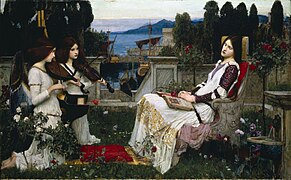
Sir Lawrence Alma-Tadema, was a Dutch painter who later settled in the United Kingdom, becoming the last officially recognised denizen in 1873. Born in Dronryp, the Netherlands, and trained at the Royal Academy of Antwerp, Belgium, he settled in London, England in 1870 and spent the rest of his life there.

Classicism, in the arts, refers generally to a high regard for a classical period, classical antiquity in the Western tradition, as setting standards for taste which the classicists seek to emulate. In its purest form, classicism is an aesthetic attitude dependent on principles based in the culture, art and literature of ancient Greece and Rome, with the emphasis on form, simplicity, proportion, clarity of structure, perfection, restrained emotion, as well as explicit appeal to the intellect. The art of classicism typically seeks to be formal and restrained: of the Discobolus Sir Kenneth Clark observed, "if we object to his restraint and compression we are simply objecting to the classicism of classic art. A violent emphasis or a sudden acceleration of rhythmic movement would have destroyed those qualities of balance and completeness through which it retained until the present century its position of authority in the restricted repertoire of visual images." Classicism, as Clark noted, implies a canon of widely accepted ideal forms, whether in the Western canon that he was examining in The Nude (1956), or the literary Chinese classics or Chinese art, where the revival of classic styles is also a recurring feature.
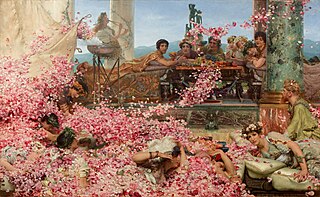
The Roses of Heliogabalus is an 1888 painting by the Anglo-Dutch artist Sir Lawrence Alma-Tadema depicting the young Roman emperor Elagabalus hosting a banquet.

The art of Europe, also known as Western art, encompasses the history of visual art in Europe. European prehistoric art started as mobile Upper Paleolithic rock and cave painting and petroglyph art and was characteristic of the period between the Paleolithic and the Iron Age. Written histories of European art often begin with the Aegean civilizations, dating from the 3rd millennium BC. However a consistent pattern of artistic development within Europe becomes clear only with Ancient Greek art, which was adopted and transformed by Rome and carried; with the Roman Empire, across much of Europe, North Africa and Western Asia.

The Lady Lever Art Gallery is a museum founded and built by the industrialist and philanthropist William Lever, 1st Viscount Leverhulme and opened in 1922. The Lady Lever Art Gallery is set in the garden village of Port Sunlight, on the Wirral and one of the National Museums Liverpool.

John William Godward was an English painter from the end of the Neo-Classicist era. He was a protégé of Sir Lawrence Alma-Tadema, but his style of painting fell out of favour with the rise of modern art.

Henry Gurdon Marquand was an American financier, philanthropist and art collector known for his extensive collection.

Spring is an 1894 oil-on-canvas painting by the Anglo-Dutch artist Lawrence Alma-Tadema, which has been in the collection of the J. Paul Getty Museum in Los Angeles, California, since 1972. The painting relates the Victorian custom of children collecting flowers on May Day back to an Ancient Roman spring festival, perhaps Cerealia or Floralia or Ambarvalia, although the details depicted in the painting do not correspond to any single Roman festival. It was the inspiration for the scene of Julius Caesar's triumphal entry into Rome in the 1934 film Cleopatra.

A Private View at the Royal Academy, 1881 is a painting by the English artist William Powell Frith exhibited at the Royal Academy of Arts in London in 1883. It depicts a group of distinguished Victorians visiting the Royal Academy Summer Exhibition in 1881, just after the death of the Prime Minister Benjamin Disraeli, whose portrait by John Everett Millais was included on a screen at the special request of Queen Victoria. The room is Gallery III, the largest and most imposing room at Burlington House.

John Reinhard Weguelin was an English painter and illustrator, active from 1877 to after 1910. He specialized in figurative paintings with lush backgrounds, typically landscapes or garden scenes. Weguelin emulated the neo-classical style of Edward Poynter and Lawrence Alma-Tadema, painting subjects inspired by classical antiquity and mythology. He depicted scenes of everyday life in ancient Greece and Rome, as well as mythological subjects, with an emphasis on pastoral scenes. Weguelin also drew on folklore for inspiration, and painted numerous images of nymphs and mermaids.
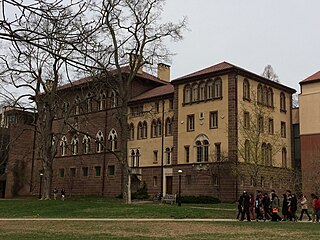
The Princeton University Art Museum (PUAM) is the Princeton University gallery of art, located in Princeton, New Jersey. With a collecting history that began in 1755, the museum was formally established in 1882, and now houses over 113,000 works of art ranging from antiquity to the contemporary period. The Princeton University Art Museum dedicates itself to supporting and enhancing the university's goals of teaching, research, and service in fields of art and culture, as well as to serving regional communities and visitors from around the world. Its collections concentrate on the Mediterranean region, Western Europe, Asia, the United States, and Latin America.

The Harris Museum is a Grade I-listed building in Preston, Lancashire, England. Founded by Edmund Harris in 1877, it is a local history and fine art museum.
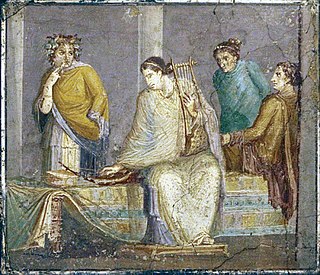
The kithara, or Latinized cithara, was an ancient Greek musical instrument in the yoke lutes family. It was a seven-stringed professional version of the lyre, which was regarded as a rustic, or folk instrument, appropriate for teaching music to beginners. As opposed to the simpler lyre, the cithara was primarily used by professional musicians, called kitharodes. In modern Greek, the word kithara has come to mean "guitar", a word which etymologically stems from kithara.

Cymon and Iphigenia is an oil on canvas painting by Frederic Leighton, 1st Baron Leighton. The painting does not bear a date but was first exhibited at the Royal Academy of Arts, London, in 1884. The Art Gallery of New South Wales in Sydney, Australia, purchased it at a Christie's auction in London in 1976.
Juan Antonio Pérez Simón is a Spanish businessman and art collector, resident in Mexico, who became rich in the telecommunications business. Pérez Simón has assembled a collection of over 3000 paintings, including works by Dalí, Goya, El Greco, Rubens, Van Gogh and Monet. In 2010, Paris Match described the collection as the largest in private hands in the world.

The Finding of Moses is a 1904 oil-on-canvas painting by the Anglo-Dutch artist Lawrence Alma-Tadema. It was one of his last major works before his death in 1912, but quickly fell out of favour; according to rumour, it was sold in the 1950s for its frame. After appreciation of Victorian painting was renewed towards the end of the 20th century, it was described in an auction catalogue in 1995 as "the undisputed masterpiece of [Alma-Tadema's] last decade, as well as a late flowering of the nineteenth-century's love-affair with Egypt". It was sold to a private collector at auction in 2010 for nearly US$36 million.
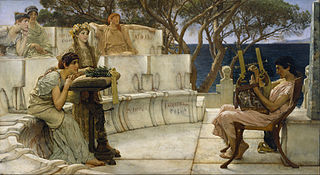
Sappho and Alcaeus is an 1881 oil-on-canvas painting by the English artist Lawrence Alma-Tadema. It is held by the Walters Art Museum, in Baltimore.

Mischief and Repose is an 1895 oil-on-canvas painting by British artist John William Godward. It has been held by the J. Paul Getty Museum in Los Angeles since 1979. Godward painted a second, smaller painting, with a different composition but the same title, in 1909.
The Bath of Psyche is an oil painting by Frederic Leighton, first exhibited in 1890. It is in the collection of Tate Britain.

The Art Collection of Henry Gurdon Marquand was a collection of antiques and paintings owned by Henry Gurdon Marquand, the second president of the Metropolitan Museum of Art, until his death in 1902.




